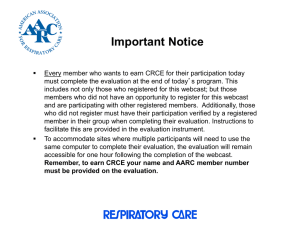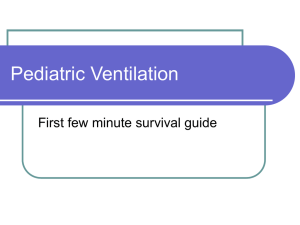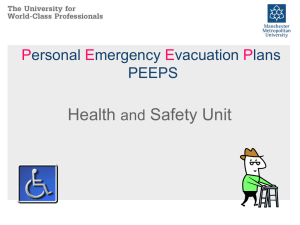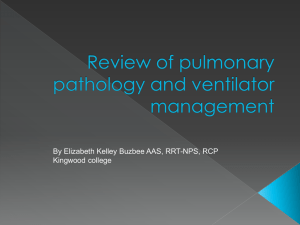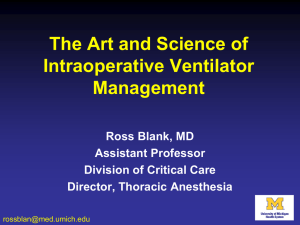Introduction to PEEP - Department for Education
advertisement
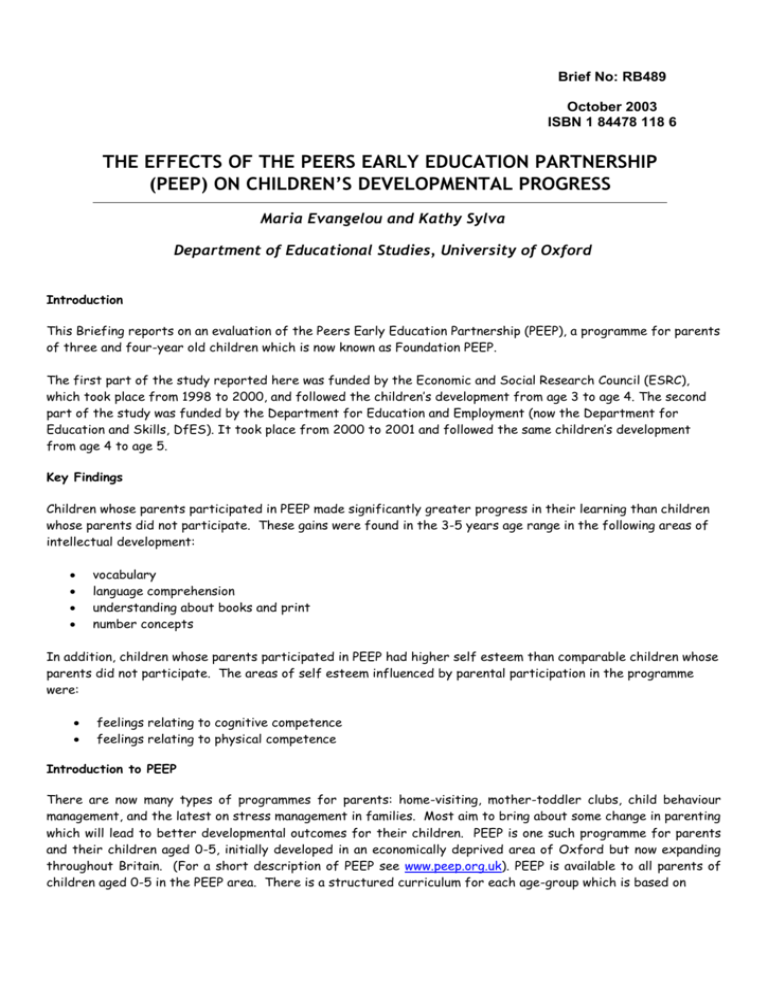
Brief No: RB489 October 2003 ISBN 1 84478 118 6 THE EFFECTS OF THE PEERS EARLY EDUCATION PARTNERSHIP (PEEP) ON CHILDREN’S DEVELOPMENTAL PROGRESS Maria Evangelou and Kathy Sylva Department of Educational Studies, University of Oxford Introduction This Briefing reports on an evaluation of the Peers Early Education Partnership (PEEP), a programme for parents of three and four-year old children which is now known as Foundation PEEP. The first part of the study reported here was funded by the Economic and Social Research Council (ESRC), which took place from 1998 to 2000, and followed the children’s development from age 3 to age 4. The second part of the study was funded by the Department for Education and Employment (now the Department for Education and Skills, DfES). It took place from 2000 to 2001 and followed the same children’s development from age 4 to age 5. Key Findings Children whose parents participated in PEEP made significantly greater progress in their learning than children whose parents did not participate. These gains were found in the 3-5 years age range in the following areas of intellectual development: vocabulary language comprehension understanding about books and print number concepts In addition, children whose parents participated in PEEP had higher self esteem than comparable children whose parents did not participate. The areas of self esteem influenced by parental participation in the programme were: feelings relating to cognitive competence feelings relating to physical competence Introduction to PEEP There are now many types of programmes for parents: home-visiting, mother-toddler clubs, child behaviour management, and the latest on stress management in families. Most aim to bring about some change in parenting which will lead to better developmental outcomes for their children. PEEP is one such programme for parents and their children aged 0-5, initially developed in an economically deprived area of Oxford but now expanding throughout Britain. (For a short description of PEEP see www.peep.org.uk). PEEP is available to all parents of children aged 0-5 in the PEEP area. There is a structured curriculum for each age-group which is based on specific curricular areas such as ‘listening’, ‘talking’, ‘numeracy’ and ‘self-esteem’. Each week the curriculum for parents includes specific books, rhymes, songs and activities. The activities are implemented in group sessions for parents and children led by a PEEP Leader and Assistant; sessions include talk time for just parents and PEEP leaders. Groups usually take place in pre-school settings. Parents are given a curriculum folder with suggestions for activities at home, and can borrow books and activity packs between sessions. The research which is summarised here focused on the developmental progress of a group of children aged 3 to age 5 whose parents participated in PEEP compared to that of matched children whose parents lived in a similar disadvantaged community in which PEEP was not available. The main research question was: Do the children whose parents have participated in the PEEP programme make greater developmental progress than matched children whose parents have not participated in PEEP? Methods Design: This evaluation was based on a quasiexperimental design. A quasi-experiment is a study in which two or more groups of individuals are compared to investigate the effect of an intervention (or treatment) on the individual. When the design is quasi rather than pure experiment the individuals are not assigned randomly to groups but are matched on characteristics thought to be related to the outcomes. Children and families were recruited in two comparable areas of economic deprivation in Oxfordshire. The only difference between the two groups of children was that the parents of one group (the intervention group) had participated in PEEP (weekly group meetings, colourful books, games and tapes to use at home) while the other group (the comparison group) had no intervention. The children in each group were similar in age and other characteristics including their language and thinking skills. This is an important feature because the group without the intervention acts as a ‘control’ on what the PEEP children might have been like if their parents had not participated. Sample: At the start, 159 children and families were recruited into the study when the children were three years old. When the children started school two years later aged 5 years 149 children remained (4% attrition). Almost every family invited to join the study did so, ensuring that the children and their families in the two groups were similar to others in their communities. Child Assessments: When children entered the study (N [number] = 73 in the intervention group and N = 86 in the comparison group) they were assessed on a number of measures: Verbal Comprehension; Vocabulary; Non-verbal Skills; Writing Sample and Social-emotional development. This was the ‘pre-test’ which sets a baseline for measuring development from age 3 to age 5. At the mid-point of the evaluation, age 4, all children were assessed on similar measures. When children entered school at age 5 (N= 64 in the intervention group and N = 85 in the comparison group), they were assessed on the following measures: Phonological Awareness (Rhyme and Alliteration); Verbal Comprehension; Writing Sample; Vocabulary; Letter Knowledge (Upper and lower case); Concepts about Print; Early Number Concepts; Social-emotional development, and Selfesteem (Cognitive and Physical Competence, Maternal and Peer Acceptance). Procedures: All children were assessed by a trained researcher in their pre-school or school. The measures were well known for their reliability and validity (Sylva, 1999). Parents gave written consent for their children to participate in the study and all agreed to be interviewed about their home circumstances, their parenting, and the child’s health and family history. To ensure that children in the two communities were receiving pre-school education of similar quality, interviews with the children’s pre-school leaders were carried out to investigate the qualifications, staff-child ratios, pedagogy and resources of the pre-schools attended by both the ‘intervention’ and also the ‘comparison’ children. No differences were found in quality. The quality of playgroups and nursery classes was compared in the PEEP and comparison area, in order to investigate whether differences in pre-school quality could account for any developmental differences found between the two groups. Results Discussion This study was designed to find the ‘value added’ to children’s development by their parents participating in a programme aimed at enhancing their skills and knowledge as first educators, and their own confidence as parents. This evaluation study has shown that parental participation in PEEP when their children were 3-5 years old was associated with greater developmental progress for their children. This progress related not only to aspects of their literacy and numeracy, but also to their self esteem. PEEP children felt more competent – cognitively and physically – than the comparison group. Given that the children in the intervention and comparison groups were closely matched and had comparable levels of development when aged 3 at the start of the study, and that the quality of pre-schools was similar in both areas, we can conclude that it is very likely that the differences between the two groups of children at the end of the study can be attributed to the PEEP programme. Statistical analysis: As it had not been possible to randomly assign the children and families to either the comparison or intervention groups at the start of the study, any background variables on which the two groups had varied at the outset were entered into the analysis as co-variates. No differences were found in attainment between the two groups of children at the beginning of the study. Thus, any differences between groups of children at the end of the study could be attributed to PEEP, and their parents’ participation in PEEP. Effect of PEEP on children: After one year of parental participation in the PEEP programme for the 3-year-olds, children in the PEEP group had made significantly greater gains in the following areas of development: Language and Literacy (Verbal Comprehension, Vocabulary, Phonological Awareness, Concepts about Print, Writing), Numeracy (Early Number Concepts) and Self-esteem (Maternal Acceptance). After two years of parental participation, children in the PEEP group were ahead of their matched (non-PEEP) peers in the following areas: Language and Literacy (Verbal Comprehension, Vocabulary and Concepts about print); Numeracy (Early Number Concepts) and Self-esteem (Cognitive and Physical Competence). Finally, the effect of PEEP was still apparent in children’s development two years after parents had started participating in the programme. The gains were: Language and Literacy (Verbal Comprehension, Vocabulary and knowledge of upper case letters) and Self-esteem (Cognitive and Physical Competence). For a detailed description of the analysis and results please see the full report published by the DfES (Evangelou & Sylva, 2003). What are the aspects of the PEEP programme which might explain the greater progress of children whose parents attended it? Some of the ways parents learn to support their children with literacy are described below. During the weekly group sessions the leaders model for parents different ways of sharing books with their three and four year old children. Parents learn to pay particular attention to: varying the tone of voice, reading the title of the story and the names of the authors and illustrators, following the text with their finger, asking questions about the storyline, linking the book to the child’s first-hand experience, and linking the book to songs or games. Approximately 70 songs and rhymes are offered in the PEEP curriculum for three year olds; and parents and children discover together the pleasure of sounds in language. As well as relating to children’s literacy outcome, these aspects of the PEEP programme are also among those which contribute to children’s understanding of their own competence. Two extracts follow from PEEP’s “Learning Together With Threes” curriculum, which emphasise the contribution of everyday talk to children’s development. From the Spring season, “Talking with children”: “One way children learn to think about things and find out more about the world is through talking. Children are full of questions (although they may not always ask them). At times, they really need an answer from us, but often they can find out their own answers. When a child asks a question, it can help to think about what he/she really wants. Sometimes a child might need attention or help, rather than an answer to the question. Talking with children can really help their learning.” 15 Norham Gardens Oxford OX2 6PY From the Summer season, “Things to Talk About”: “Parents and carers can offer lots of opportunities for children’s talking. Children get better and better at talking, when they have lots of things to talk about. They need someone to talk with who listens, joins in and tries to understand. Going out, having picnics and making books together are three good opportunities to encourage talking.” Additional Information Using a quasi-experimental design, this evaluation has shown the positive impact of PEEP on children’s literacy, numeracy and self esteem. It has demonstrated through rigorous evaluation that supporting parents as first educators through the PEEP programme has significant developmental outcomes for their children. Further research studies are now needed to tease out which components of the PEEP programme are responsible for these impacts on different aspects of children’s development. References Evangelou, M. and Sylva K. (2003). The Effects of the Peers Early Education Partnership (PEEP) on Children’s Developmental Progress. London: DfES Evangelou, M (2001). Evaluation of the Effects of Pre-school Intervention on Literacy Development in Children D.Phil thesis, University of Oxford Sylva et al (1999). An Introduction to the EPPE project London, DfEE and Institute of Education, University of London Author contact information and web sites for PEEP and FELL Research Group Dr Maria Evangelou maria.evangelou@edstud.ox.ac.uk Professor Kathy Sylva kathy.sylva@edstud.ox.ac.uk University of Oxford Department of Educational Studies http://www.peep.org.uk/ http://www.edstud.ox.ac.uk/FELL/FELL.htm Copies of the full report (RR489) - priced £4.95 are available by writing to DfES Publications, PO Box 5050, Sherwood Park, Annesley, Nottingham NG15 0DJ. Cheques should be made payable to “DfES Priced Publications”. Copies of this Research Brief (RB489) are available free of charge from the above address (tel: 0845 60 222 60). Research Briefs and Research Reports can also be accessed at www.dfes.gov.uk/research/ Further information about this research can be obtained from Gail Windrass, L2, DfES, Caxton House, Tothill Street, London SW1H 9NA. Email gail.windrass@dfes.gsi.gov.uk The views expressed in this report are the authors’ and do not necessarily reflect those of the Department for Education and Skills
